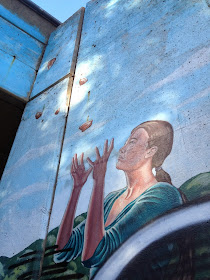Now,
where was I?
That’s
right, it’s autumn here in Philadelphia.
Now,
how does that quote go again, the one about autumn? Think, Jon Spruce. Who was it again?
That’s
right, it was Albert Camus, the French philosopher. Now, he was an absurdist but don’t worry,
Donny, there’s nothing to be afraid of.
Every
now and then, even an absurdist is worth listening to.
Autumn is a second spring when every leaf’s a
flower.
Zut
alors! He was right.
Season
of the tawny dawn, season of the rustic twilight, the brisk walk…
…the
green world’s final curtain call.
Now,
Jon Spruce, pay attention.
This
is how it turns. This is how it falls.
What’s
the first to blaze? The very tippy tops
of maples.
Next,
it’s the sycamores, last to leaf but first to drop.
Do
you want to see one of the largest sycamores in all of Turtle Island?
That’s
the Buttonball Tree, located in Sutherland, Massachusetts. Estimated age? 350 years old.
The
most famous sycamore in Pennsylvania?
It’s
got to be the Lafayette Sycamore in Valley Forge National Historic Park. Do you want to see a picture?
Oh,
that’s right. Here, I found another one.
During
the Battle of Brandywine, the injured Marquis De Lafayette was rushed away from
the battlegrounds and laid against this sycamore while his wounds were dressed.
Or so the legend goes.
Here
in Philadelphia, I like the stand of sycamores in front of the Art Museum.
In
the buzzing metropolis known as the Appalachian forest, the sycamore stands out
like a statue…
…here is a tree, wrote Donald Culross
Peattie, that might have been created as
the friend of mankind.
During
these drizzly October days, its camouflage bark gets a good, hard scrub against the washboard...
…first
sign of the motley autumn to come.
Sycamores
and maples but then there’s more. From
underneath its thick green crown, the eastern ash is turning on, incandescent.
Hunting yellow, are you? Then you must be in hog heaven, can’t steal
your eyes away from all those honey locusts.
The
big trees are a-catching color but, Jon Spruce, don’t get too distracted, watching
that rustic quilt drop from the sky. Don’t
miss the understory.
That’s
the sumac, not the poisonous kind, one of the first small trees to blush.
And
then see those golden coins, hanging in mid-air, catching color?
That’s
the poison ivy, the poisonous kind…
…although
sometimes it flares red, don't know why.
And, Jon Spruce, quit your babbling for one minute and listen, listen while you walk…
…we should go forth on the shortest walk,
Thoreau once wrote, in the spirit of
adventure, never to return.
Never
to return.
Now
that’s it. That’s the way autumn sounds
to me.
The
world is a-creaking.
It’s
the cracking of the horse chestnuts…
…the
way the acorns pop under my path.
It’s
the sound of my boots stirring the autumn carpet, the way those leaves whisper
against my jeans.
Now
that’s the way you take a fall.
FERNHILL FRUIT
It may be worth
the while to consider for a moment what a fruit is.
That’s
another quote from Thoreau. Can’t help
it, the guy never stopped talking.
And
that’s exactly what I was up to. I was
considering the fruit.
So I crawled back into the car and headed into the direction of the Northeast, as good a place as any, and better than most...
…to Fernhill
Park, at the intersection of the Roberts and Wissahickon Avenues.
In
the distance, across the baseball field, the mulberry takes center stage.
This
is a fabulous mulberry, not something
you’ll hear me say very often.
The mulberry is not one of my favorite trees, not by a long shot, but
that would change in a heartbeat if more mulberries looked like this.
Nice
shadow too.
Around
the bend from this mulberry, the path ducks under the Roosevelt Expressway
overpass…
…and,
there, you’ll find a colorful mural, a vivid and enigmatic consideration of the
fruit.
I
don’t know, exactly, what that fruit is trying to be.
I
can’t identify it.
Not
a good way to start a hunt.
Along
the mural, I found some of the fruit floating in the air, a-sprouting…
…but
that was just absurd.
Some
of the fruit on the mural is cracked open…
…but
that still didn’t help.
Maybe
an acorn?
Its
tree kind of looks like an oak…
…but
there’s no way to be sure.
If
only I could meet someone who knew for sure…
…someone
who had a hand in the sowing.
Maybe,
in order to find the answer, it would be worth the while to look even deeper, to
get on my knees and to peer inside the fruit itself.
Maybe
I should consider the seed.
And,
for that, I recommend doing your reaping at a local farmers’ market.
CONSIDERING THE
SEED
In
most cultures and countries here along the northern slant of the world, this
part of the year is known as the Harvest Moon.
Delicious,
nutritious, colorful, juicy and rich, but that’s the whole idea after all.
That’s
how these fruits spread their seed.
They’re
made to be irresistible.
In
reality, these flavor-bombs are just the vehicle for its passenger, the seed.
Now, let’s
get dirty.
Here
we have the inedible gourd, kept in the seed catalogs all these years for décor
and tradition. Many, many Harvest Moons
ago, these kinds of gourds were valuable material, whittled down to make spoons
or bowls, carved out to make water jugs or bird-feeders, or carved out and then
filled back up with dried corn to make musical instruments.
Like
most winter squash, the gourd packs all of its seeds in a soft, doughy pocket
inside the fruit.
Wet,
fleshy strings help keep them in place.
Then
there’s the pome.
Unlike
the squash, the pome has a distinct core, right in the heart of the fruit.
And,
unlike the squash, the seeds are few and packed tight.
There’s
also the nightshades.
Unlike
the squash and the pome, these seeds are packed inside watery pools known as locular cavities.
It
comes from the root word loculus,
which means small space, although in
archaeology, it means a small chamber set aside the antechamber of a catacomb.
My
final seed vessel of the day’s harvest? The
capsicum.
Unlike
all the rest, these seeds dangle on a weak hinge along the inner rim of the
fruit, hanging delicately from the soft, papery placental wall.
It’s
good eatings with Jon Spruce but, in the grand scheme of things, edible fruit
makes up a very small population of the fruiting world.
If
you only got an appetite for edible seasonal fruit, you’re going to miss a
helluva show.
THE HARVEST MOON
That’s
the black walnut, shelled and cracked and eaten by some friendly, neighborhood
Fernhill Park squirrel.
We’re
already deep here.
Its summery green
husk, which is technically the ovary, has already dried up and shed, revealing its
wrinkled pericarp shell.
The
edible nut has already been savored but there is still value in that tough
shell.
Ground
up into grit, walnut shells are used to clean and polish soft metals,
fiberglass, even jet engines. It’s even
used to clean off graffiti.
Unlike
the walnut, the Kentucky coffeetree carries its seeds, not in a shell, but in a
pod.
And,
unlike the walnut, these seeds are wet…
…stuck
in place, slimed, in a swamp of green pulp.
Native
Americans and starving colonial armies used to crack these seeds for the beans
inside…
…roast
them and brew them into something that, supposedly, tasted like bad coffee.
Things
get even weirder when you consider the magnolia.
One
of our most ancient, oldest surviving trees, the magnolia fruit is called a follicle.
That
means that the seed is encased inside the fleshy fruit, the follicle. The seed will eventually work
its way out, inching towards the soft wall until it breaks free of the fruit and
falls to the ground.
I’m
not waiting around for that.
But
my favorite fruit of the hunt? It was
something even more peculiar, something even more fabulous and rare in these
here parts.
That’s
the native persimmon.
It’s
much more common, although not common at all, in the southern part of the
Appalachian chain, flourishing in the Shenandoah Valley of Virginia, although
most field guides will include this part of the Delaware River Watershed as part of its
native range.
It
is easily recognized by its spray of contorted branches and its distinctive,
blocky bark…
…described
in the field guides as resembling
charcoal briquettes.
Charcoal. Now that’s what autumn smells like to me.
In
some parts, it’s called possumwood. That's because its fruit hangs and persists on the branches
during winter, a favorite food for Turtle Island’s only native marsupial,
the possum.
So
popular among the possums that, when John James Audubon painted the critter for
his collection, he depicted it climbing along a persimmon branch, winter on the tree.
These
are not the kind you find in the supermarket.
That’s
the Chinese persimmon, although the Turtle Island persimmon does share the
same characteristic of fruiting and clinging close to the branch.
It’s
an obstinate fruit.
A
real trickster.
Have
you ever bit into an unripe persimmon?
You’ll
need a good five minutes to untangle your mouth.
In
the words of colonial Captain John Smith, if
it be not ripe, it will draw a man’s mouth awrie with much torment.
Instead,
you have to wait, wait almost all autumn long, at least until a first
frost. You have to wait until the skin
is wrinkled, until it’s soft and mushy to the touch, until it’s completely
unappetizing to the eyes, rotten to the mind.
Then,
you eat it.
And
then you’ll know it by its true name, Diospyros
viriginiana, roughly translated to the fruit
of the Virginia Zeus.
But
it takes time, Jon Spruce, it may take even longer than you think to
ripen.
You got to leave this one on the branch.
It’s
a fruit that rewards the patient, for the peaceful and the poised, a fruit not
to be rushed into or else you risk the chance of torment and awry.
Be
like the persimmon, Jon Spruce. Be
patient.
Like
the Good Book says, you gonna reap just what you sow.
































































Beautiful pictures with beautiful information. You have done a very good job by sharing these informative guides. Keep sharing good work. Keep it up and Thanks
ReplyDelete